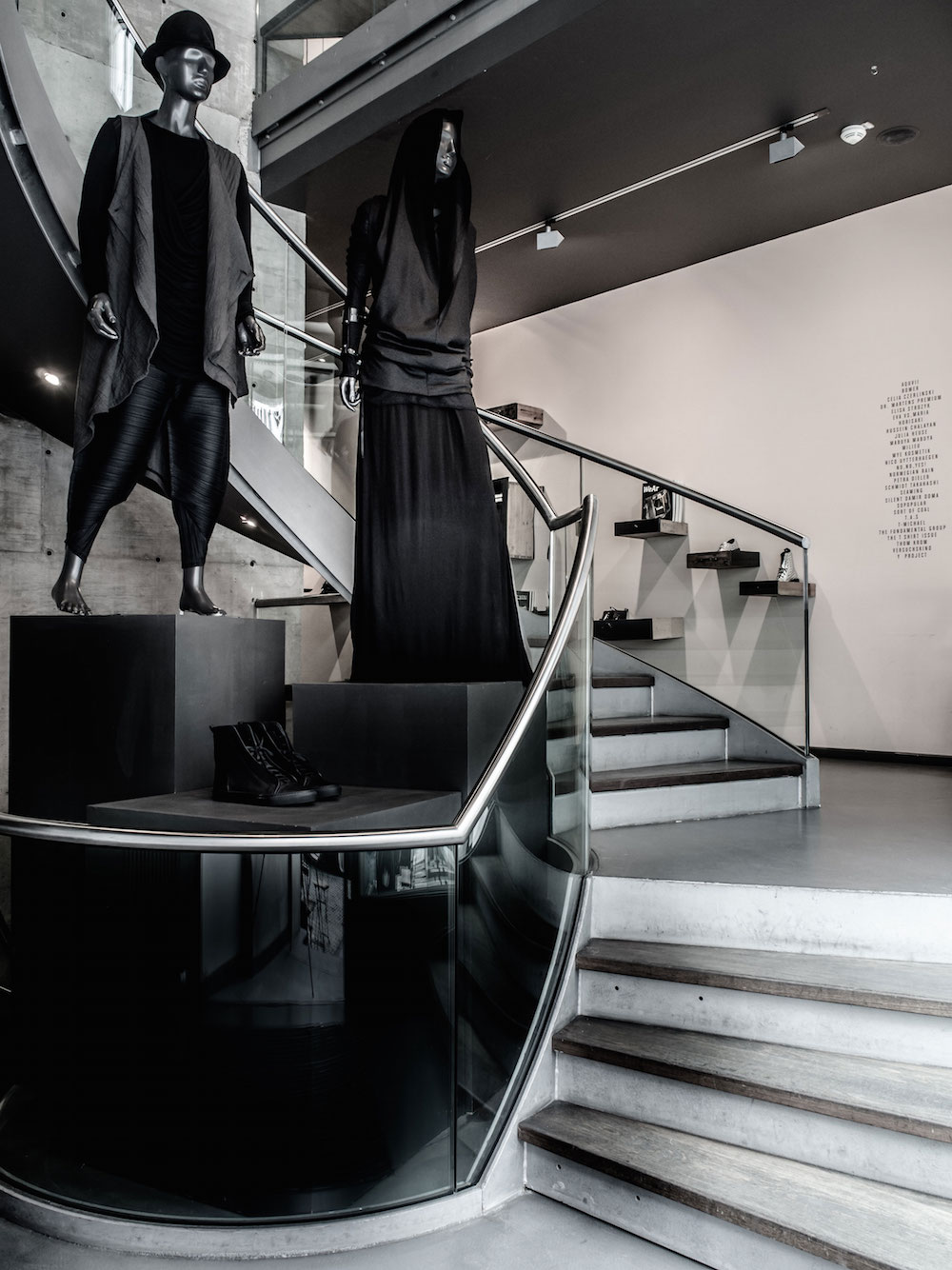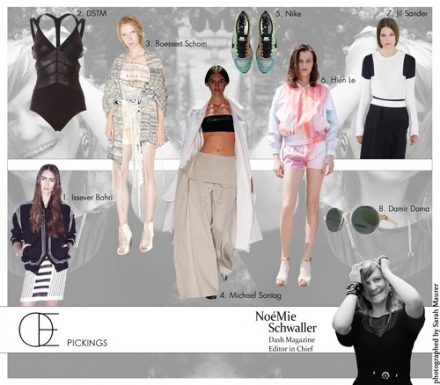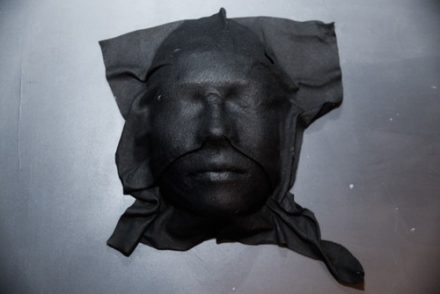
Serving as a focal point of recent fashion discourse, it is no secret that industry pace is verging ever closer on break-neck, fuelled in part by a spoilt consumer long since accustomed to an instantaneous satiation of their every material whim. Berlin offers few better opportunities to review the precarity of this corporate-consumer paradigm than on Mitte’s main commercial drag, Friedrichstraße, where heritage-steeped houses and fast-fashion conglomerates alike unabashedly peddle illusions of lasting quality and worth, the ephemerality of which is unveiled with the advent of the next season.
Oukan’s tenancy of an address just at the wayside of the path well trodden therefore takes on a fortuitous symbolism, playing on the same field as its immediate market competitors, albeit under a wholly idiosyncratic, self-imposed set of rules. But wherein lies Oukan’s differentiating crux? Well, perhaps in its surpassing of both initial perceptions and expectations; the physical façade, each square inch of which suggests an almost unfamiliar fastidiousness, is but a portal to a wider universe, each facet of which predicates on a rare-to-happen-upon doctrine of singular commitment, expertise and a profound respect for the importance of allowing for ample space and time.

“[About 80%] of the staff here trained as designers”, confides owner Tran Mai Huy Thong, who himself graduated from the prestigious Central Saint Martins MA Womenswear course in the same class as Richard Nicoll and recently appointed Diane von Furstenburg creative director Jonathan Saunders. Such intimate acquaintance with the obstacles faced by the emerging crop of talent affords Oukan a uniquely humanist, almost patron-ly, air, eagerly investing in the sustainable success of those with whom they work. This is facilitated by the intricacy of its compositional framework, with the Oukan Lab, a forum for consultancy and concept development, representing as crucial a component of Oukan’s overarching structure as the retail space itself. Under this division, brands stocked by the store are offered direct advice, the value of which is naturally boosted by the Lab’s immediate market proximity, which also facilitates the hosting of numerous events across the calendar, the primary purpose of which is the indispensable introduction of newly discovered talents to a select crop of press, as well as to its loyal client base.

Such diligent efforts on Oukan’s part may certainly allow for it to fall under the banner of the hackneyed expression, ‘going the extra mile’, but such a trite evaluation represents little more than a grave discredit, and in fact highlights the divorce of the now ubiquitous ‘concept store’ from its very ideological foundations, ones in which Oukan remains firmly rooted. Huy Thong is quick to underscore that the original concept stores insisted on “working extremely closely with the designers and labels”, with the buyer-designer relationship often so intimate that it was more akin to a friendship than to the clinically commercial association seen so prevalently today. Yet, given that ‘concept store’ has come to represent little more than a marketing gimmick, Huy Thong is somewhat loath for his progeny to be cobbled under such a banner. And rightly so; as touched upon above, a crucial facet of the Oukan empire is indeed the Lab, whose reach extends further than the store itself, developing concepts for fellow stores, hotels, and even restaurants alike.

One may initially be left scratching ones head as to how this is at all congruous with an institution better know for the retailing of international avant-garde fashion, but the Lab’s role in the overall framework is not to be underplayed, or dismissed as an entrée to a main course. In the development of whichever concept it may be, designers are directly woven into the process, immersed to such an extent that “all [those who] want to be involved in the project need to work at least one week in the hotel or restaurant”, for example, an unorthodox approach at the very least. Why? “It’s much more interesting to create a concept [in direct collaboration] with all parties involved ”, from the commissioners, to the workers, to the designers. Not only does this facilitate the realisation of an entirely integrated concept, but it skirts around the all-too-real risk of creatives yielding the cherished fruits of their labour to corporate entities, only to have them warped beyond recognition. On a much more pragmatic level, it offers the rare and invaluable opportunity for designers to gain insight into the practical applications of their work in real, operational contexts.

Silvia wears dark grey canvas – Un-namable, blouse and trousers – Pleats Please by Issey Miyake, chelsea boots – Camper, belt – Y/Project; Styling by Silvia Scutari & Tran Mai Huy Thong
In light of this, Oukan can perhaps be better thought of as a bridging host, an intermediary between client, corporation and creative, able to offer apt insight to each party on account of their direct involvement with each respective sphere. Nowhere is this logistical versatility more evident than in its relationship with the Japanese designer community, of which Oukan is one of the most avid proponents in Europe. The clue is in the name, with ‘Oukan’ translating from the Japanese for ‘crown’ or ‘diadem’. While Western infatuation with the Eastern avant-garde is hardly novel, Oukan’s approach is bound with a shared mentality rather than with exoticist fetish. With reverent fascination, Huy Thong tells of the dedicational depth of Japanese fashion culture, recalling designers that “work for seven to eight years on a single idea, not earning anything [save for] part time earnings. Only when they are sure that [the idea] is ready do they release it onto the market”. Indeed, such an approach rings wholly true here at Oukan; the term ‘slow retail’, an antidote to the fast-fashion pandemic, crops up frequently across the length of our chat, a philosophy that places firm emphasis on allowing the necessary time and space for a purchasing decision to be made of its own harmonious accord.

In spite of the impeccable quality of the work of these young Japanese designers, there are often lessons to be learned, from the mundanely practical to more profound matters of differentiating business custom and mentality. “Of course one of the easiest things to tackle is the sizing”, with Japan infamous for measurements that would have even the most petite of European clients blow absurdly out of proportion. Yet a real gulf in attitude emerges with regard to marketing and to production capacity. Japan’s avant-garde is famously marketing shy, with even the nation’s most revered brands, Comme des Garçons for example, refraining from the aggressive, garment-exhibitory ad tactics familiar in the West. Quality, of both fabrication and concept, is to speak for itself, with PR bells and whistles serving as little more than illusory means to amplify the worth of an otherwise inferior product. Such is the dedication to the maintaining of these stringent quality standards, that even in the face of mounting demand, “if an order is placed that is beyond their production capacities, they will immediately say ‘No, we can only produce up to 100 pieces, [for example]. For more, you’ll have to wait until next season.’” After all, limiting production for the sake of ensuring a product of the highest calibre is a smaller price to pay than any other.

Laura wears hoody scarf – Jeonga Choi, coat – Pleats Please by Issey Miyake, trousers – Y/Project, ankle boots – Camper; Styling by Silvia Scutari
Given the reluctance to engage in the marketing rabble to which we in the West have grown so accustomed, how does one go about packaging a brand, old or new? One of Oukan’s greatest success stories may come as somewhat of a surprise: Issey Miyake. One may not have thought that a brand of such wide critical acclaim would, or could, have fallen by the wayside, but, in humbling testament to the unforgiving speed of the contemporary fashion cycle, such was the case. With the gradual ageing of its client base, conversation surrounding the brand has died down, instigating Huy Thong to set about its revival. “I don’t think there was a single concept store in Europe stocking Issey Miyake at the time!”, he quips. So how did Oukan go about such a mammoth task, reviving the credibility of an international design icon from their Berlin base? “We enlisted various stylists, creating a new look each week that combined Miyake pieces with those from younger brands”, an ingenious way of reintroducing the brand to a fresh audience, all while sticking to Oukan’s commandments of understatement and of allowing quality to speak for itself.

Anton wears long-sleeved mesh sweater – Delusion, overcoat – Damir Doma, combat boots – The Last Conspiracy; Styling by Silvia Scutari
Huy Thong’s reintroduction of Miyake to the niche European market was widely praised, perhaps because of the placement of such a storied label within a new, unfamiliar context of youthfulness. However, this attitude of recontextualisation does not limit itself to individual brands, but to whole aesthetics in and of themselves. A brief perusal of the store reveals a predominant palette of anti-colours: cool greys, brilliant whites and, most notably, sombre blacks. Keen to depart from stereotyped neo-goth connotations, the Oukan team seeks, each season, to reinvent their shadowy medium, working tirelessly to forge concepts that reflect the true versatility of the monochrome spectrum. Last season saw a focus on “urban activities, [entailing the creation of] an entire concept centred on movement and sport”, all while steering clear of overly seasonal trends in favour of showcasing each piece in a resolutely timeless light.
In the midst of this meticulously curated retail emporium lies a restaurant, a cosy space on the building’s upper floor, furnished with high stools and wooden tables. It is here that Huy Thong has so graciously hosted me over the course of our discussion, during which it has become increasingly clear that the restaurant is being employed for a range of purposes, from catch-up coffees to post-purchase snacks. Boasting a rotation of Asian-fusion snacks, among them bao bun burgers with toasted nori and sweet ginger teas, the space offers Oukan customers, be they browsing or purchasing, an opportunity to pause and fully immerse into the experience at hand. If ‘slow retail’ is to have a dwelling, it is surely here: “quality convinces by itself, we don’t have to push or convince anyone; just offer them a comfortable space to drink tea or even to eat a small snack”, to take the time to let a perfume develop, or see if that pair of shoes fits just right. In its banishing of hastiness, Oukan becomes an oasis of timelessness in which the relationship between buyer and product shifts from an act of dehumanised exchange of wealth for goods to an effectual personal experience. The mass-market perpetuation of a ‘one-size fits all’ philosophy is reduced to a farce, predicated upon the maintaining of an industry speed so dizzying that our engagement with it can hardly be deemed rational or sober; a step back, as facilitated by Oukan, reveals the virtue of a conscious individual engagement with the act of consumption, proving that, when faced with the task of standing the test of time, slow and steady wins the race.

All images via Golo Pauleit
Oukan can be found in Berlin’s Mitte, at Kronenstraße 71. Nearest U-Bahn – Stadtmitte. For those not residing in Berlin feel free to consult their online store.





